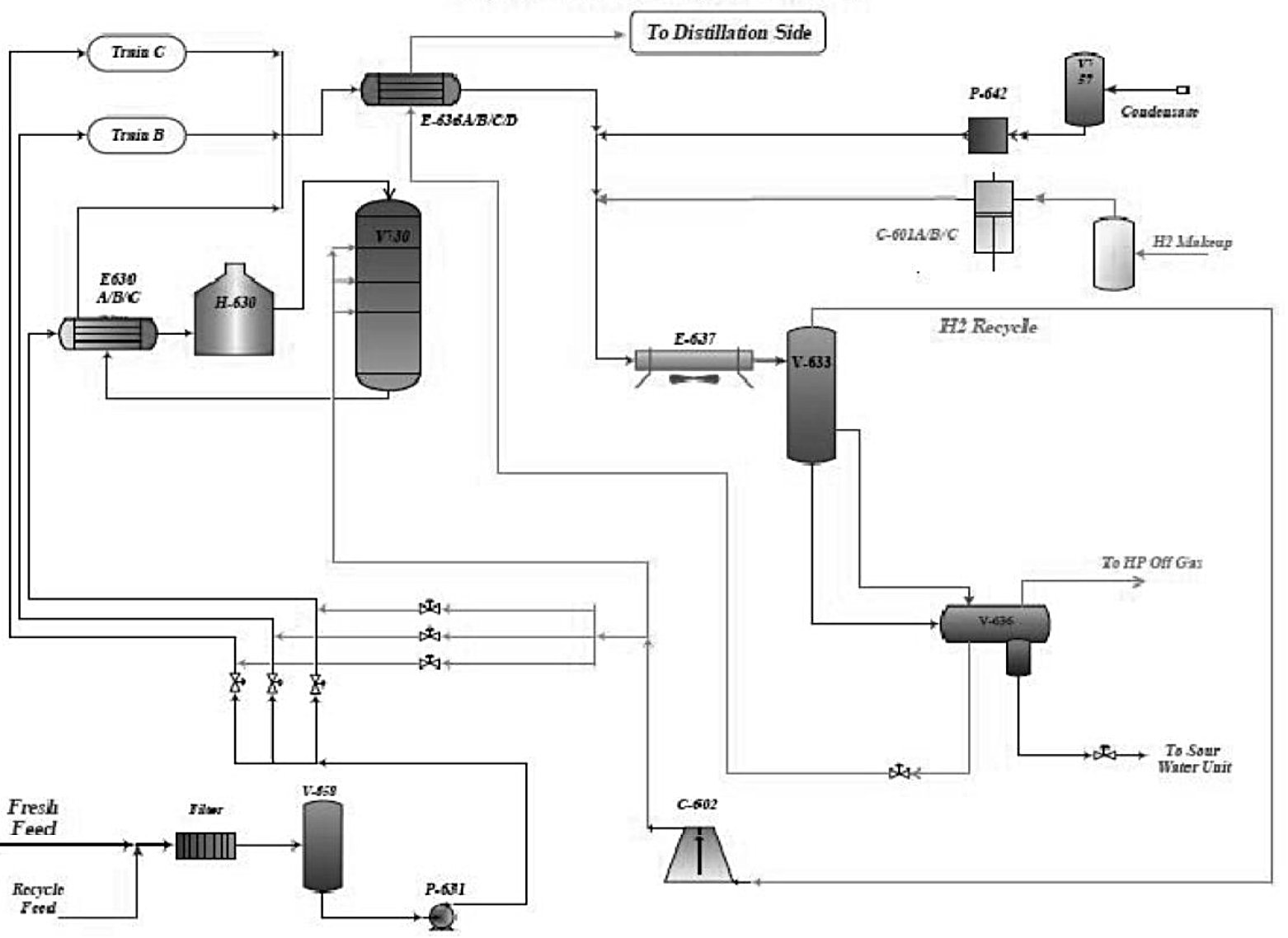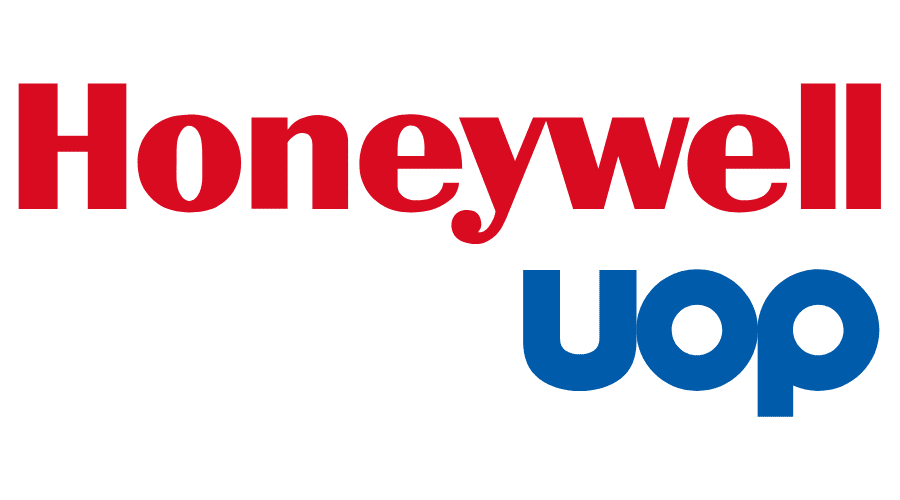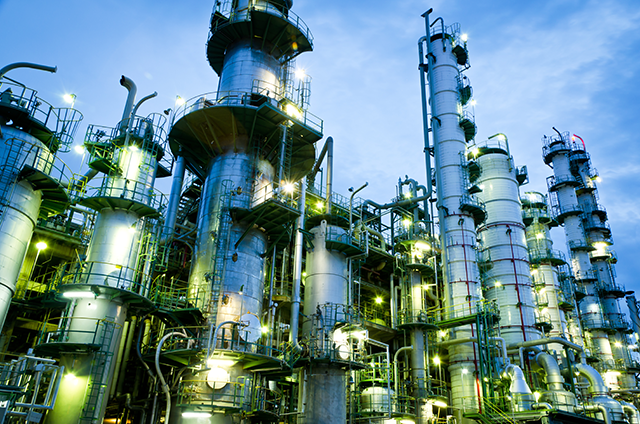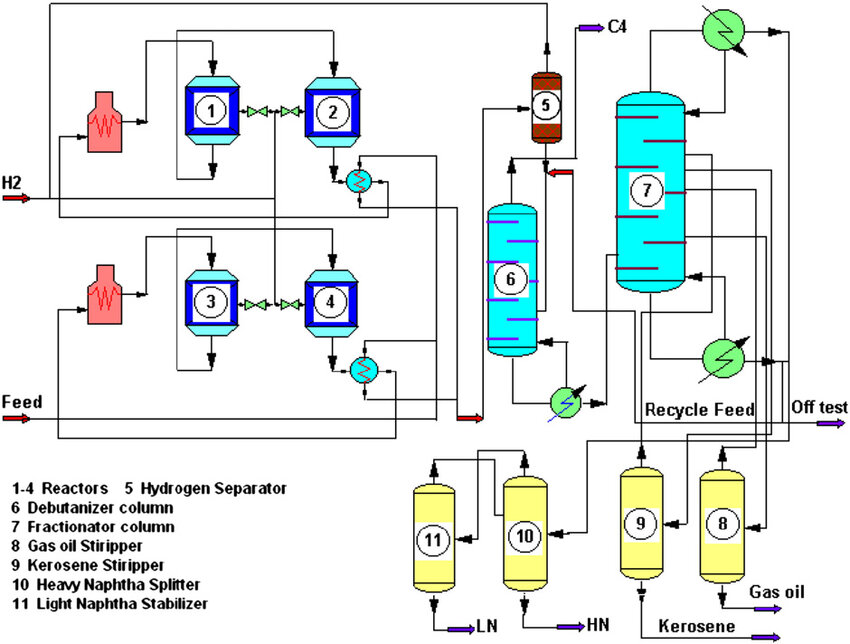The UOP ISOMAX process represents a significant milestone in hydrocracking technology development, being one of the earlier commercial applications of fixed-bed hydrocracking that enabled refineries to convert heavy feedstocks into valuable middle distillates. The process operates as a two-stage, fixed-bed catalyst system designed specifically for upgrading vacuum gas oil (VGO) and other heavy distillates into high-quality products including naphtha, kerosene, and ultra-low sulfur diesel.
Technology Classification and Configuration
ISOMAX belongs to the fixed-bed hydrocracking category, utilizing stationary catalyst beds through which the feedstock and hydrogen flow in a downward direction. The process is characterized as a two-stage configuration where:
- The first stage performs both hydrotreating and partial conversion of the feed
- The second stage provides the remaining conversion of recycled unconverted oil to achieve overall high conversion
The technology operates under moderate conditions with hydrogen pressures ranging from 500 to 1,500 psig and temperatures between 205-370°C, depending on feedstock characteristics and product requirements. Hydrogen consumption typically ranges from 1,000 to 1,600 SCF per barrel of feed processed.
Figure 1 - Process Flow Diagram (Reactor Side) of ISOMAX Technology[3]

Process Description
The ISOMAX unit comprises three main sections:
- Make-up compressor section: Compresses 96.5% hydrogen gas in three stages from 15.5 kgf/cm² to 190 kgf/cm²
- Reactor section: Contains fixed-bed reactors where hydrocracking reactions occur
- Fractionation section: Includes debutanizer tower, fractionation tower, splitter, and stripper for product separation
The process flow involves mixing fresh feed with bottom recycle streams and hydrogen before introduction to the reactors. After reaction, products flow to the fractionation section where they are separated into various cuts including light gases, butane, light naphtha, heavy naphtha, kerosene, and gas oil.
Comparison of UOP's Hydrocracking Processes
Evolution from Earlier Technologies
The UOP hydrocracking technology timeline shows the evolution:
- 1950s: UOP HDC Unibon Process (hydrotreating and hydrocracking)
- 1960s: UOP HC Unibon Process (hydrocracking)
- 1970: UOP Lomax Hydrocracking Process
- 1980: UOP ISOMAX Process
- 1990s: UOP Unicracking Process (current technology)
Comparative Use Cases
- The Lomax process preceded ISOMAX and provided refiners with flexibility to produce various product ratios
- ISOMAX represented an advancement with improved two-stage operation, designed primarily for vacuum gas oil upgrading, effective for feeds with moderate contamination levels, and optimized for middle distillate production (diesel, kerosene, jet fuel).
- Unicracking process is UOP's more modern and flexible hydrocracking technology offering multiple flow schemes (single-stage, two-stage, once-through, and separate-hydrotreat), providing greater operational flexibility with the capability to handle a broader range of feedstocks, as well as incorporating more advanced reactor internals, including the Uniflow distribution system for improved catalyst utilization.
- Slurry-phase technologies (like UOP Uniflex) handle heavier, more contaminated feedstocks.
Commercialization Status
Based on available evidence, ISOMAX technology is no longer actively commercialized by UOP. Several indicators support this conclusion:
- Technology Evolution: UOP's current marketing materials and technical literature focus on the Unicracking process as their primary hydrocracking technology offering.
- Historical Context: The technology timeline shows ISOMAX was developed in the 1980s, with Unicracking becoming the successor technology in the 1990s.
- Current Operations: While existing ISOMAX units continue to operate such as those in Iran (Tabriz, Tehran, Arak), Spain (Cepsa San Roque) and other locations, new licensing appears to have transitioned to the more advanced Unicracking technology. These legacy UNIMAX units typically process 12,000-18,000 barrels per day of vacuum gas oil, producing high-quality middle distillates meeting modern fuel specifications.
- Recent Incidents: The 2025 fire at Chevron's El Segundo refinery affected the "Isomax 7 unit," indicating that existing installations continue operating under the ISOMAX designation, but these represent legacy units rather than new technology deployments.
Technical Advantages and Limitations
Advantages
- Proven reliability in two-stage fixed-bed configuration
- Moderate operating conditions compared to more severe processes
- Effective middle distillate production from VGO feedstocks
- Established catalyst systems with understood deactivation patterns
Limitations
- Limited feedstock flexibility compared to modern technologies
- Lower conversion potential than advanced configurations
- Less energy efficient fractionation compared to novel schemes
- Catalyst deactivation requiring periodic regeneration or replacement
References
- Ian Clarke. Dec 5, 2017. UOP Hydrocracking Technology, Upgrading Fuel Oil to Euro V Fuels. Bottom of the Varrel Workshop | NIORC , Tehran. VCMstudy.
- G. Zahedi, S. Mohammadzadeh. Aug 2011. Modeling and optimization of an industrial hydrocracker plant. J. Pet. Sci. Eng., 2011, Vol. 78, pp. 627-636.
- A. Moghadassi, N. Amini, O. Fadavi and M. Bahmani. Hydrocracking Lumped Kinetic Model with Catalyst Deactivation in Arak Refinery Hydrocracker Unit. JPST, Vol.1, No.1, 2011, pp. 31-37.
- Isomax Hydrocracking Process Guide. Uploaded on SCRIBD on Aug 9, 2015.
- S. Simpson, V. Thakkar, D. Ackelson, L. Wang. Jun 29, 2008. Paper Nr. WPC-19-2436: Unicracking Technology Advances For Re-balancing Diesel Gasoline Production. 19th World Petroleum Congress, Madrid, Spain. Onepetro.
- V. Piemonte. Jul 19, 2016. Process & Catalyst Innovations in Hydrocracking to Maximize High Quality Distillate Fuel. Oil & Gas PORTAL.
- M. Wagner da Silva. Aug 9, 2021. Maximum Added Value to the Crude – The Synergy of Hydrocracking and Carbon Rejection Technologies as Residue Upgrading Strategy. Linkedin.
- G. Toohey, K. Garcia. Oct 8, 2025. What caused the massive El Segundo explosion? Refinery experts have some theories. Los Angeles Times.












